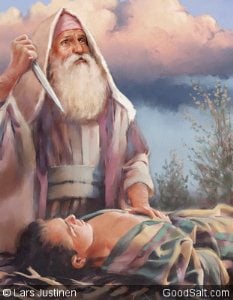Monday: The Gospel in the Old Testament
 When is the first promise of salvation given, and what does it mean? Gen. 3:15. 1
When is the first promise of salvation given, and what does it mean? Gen. 3:15. 1
The language here is striking. Adam and Eve have sinned. Now the great controversy is announced to them through the strong language of “enmity” between two opposing sides. This is a precious promise for human hearts now attracted to sin. We are also assured that this major conflict will not be eternal, for the head of the enemy will one day be crushed. In these verses, not only is the great controversy first revealed, but we also are told how it is going to end.
Paul took courage from Genesis 3:15. How does he express it in Romans 16:20? What point is he making?
In Genesis 22:1–19, Moses also narrates an amazingly graphic atonement picture. What can we learn about the future atonement of Christ from this narrative?
Note the many mentions of “father and son” and how they go to the mountain of sacrifice together. The son carries the wood and the father the instruments of sacrifice (fire and knife). Isaac, much younger than his father, could have overpowered Abraham on the mountain of sacrifice. But, instead, we see two miracles: the father yielding his son, and the son yielding his life.
What a powerful representation of the sacrificial death of Christ on our behalf. The scene, however powerful and moving, was only a tiny foretaste of the time when centuries later another Father would offer His Son. This time, however, there would be no animal to die instead of the son. The Son Himself would die on the altar. The Father would truly give up His Son, and the Son would give His life.
There, on Mount Moriah, the world has been presented a very powerful picture (but still only a picture) of the plan of salvation and what it cost to redeem fallen humanity from the ruin of sin.
To select a different email delivery time, please click here.
 (0)
(0)
Comments
Monday: The Gospel in the Old Testament — No Comments
Please make sure you have provided a full name in the "Name" field and a working email address we can use to contact you, if necessary. (Your email address will not be published.)
HTML tags allowed in your comment: <a href="" title=""> <abbr title=""> <acronym title=""> <b> <blockquote cite=""> <cite> <code> <del datetime=""> <em> <i> <q cite=""> <s> <strike> <strong>